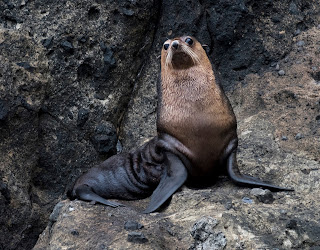It was a wonderful two days of landscape vistas, birds, and enjoyment of places few get to see, and I am sure we will never get to see again
Nightingale Island
luckily this island is rat free, as in no rats inhabit the island causing destruction of seabirds, despite some shipwrecks there, that is lucky
This small island is actually still an active volcano as it erupted in 2004 on an undersea vent, something it has not done they believe in tens of thousands of years. In many respects, it has its own ecosystem and is home to endemic birds despite its size. Landing is difficult and even cruising the island up close with Zodiacs can be impossible but we still had this rare favorable weather pattern so we got lucky.
Nightingale Island Finch, a song bird endemic just to Nightingale, one of three passerines found there. The species on these two islands are a mess as the finches found on Nightingale and Inaccessible Islands are sometimes considered subspecies of one larger species complex. It is quite obvious that they evolved from a common vagrant flock. The larger billed Wilkin's finch (not pictured) seems different enough to be considered a true species. I did not see finches on Inaccessible
Tristan Thrush, I photographed all three subspecies found on the three islands. The thrush on Nightingale are very dark.
subantarctic fur seals
The local Tristaners go to Nightingale for vacation, here are some cabins
Moseley's rockhopper penguin swimming
And here are more being chased around by a cheeky fur seal
Inaccessible Island
This larger island is almost inaccessible, and is difficult to even explore. I had hoped that a Zodiac cruise around would discover its endemic inaccessible island rail, the holy grail of birds but alas no luck in that. I only saw more penguins and a lot more thrush, finishing the triumvirate of Tristan thrush subspecies
Elephant seal
Moseley's rockhopper penguin, penguin #7 for the trip
Inaccessible ssp. of Tristan Thrush
Tristan da Cunha
Many of you have talked about the "port." There is no port. They unload supplies onto pontoons and then small fishing boats tow them to shore. Cargo ships have been known to come wait a week and leave without ever being unloaded. They then lift items onto shore using the yellow crane, including the fishing boats, nothing stays in the water very long.
There is a bit of a jetty but it gets washed away every year. Some smart person thought they should use wind power here. They put up some towers and the first winter they had a big wind and all the towers blew over and were destroyed. Such is the life here.
It was almost doldrums calm here mysteriously when we showed up. The locals even patted us on the back for the luck as we'd have to be ferried by Zodiac to shore and back, but the weather held for two days. Our last day we circumnavigated the island. Almost saw the volcanic peak, Went past the village and gave them a greeting toot and then we turned east and left, literally at that very moment the wind picked up, the clouds returned and the seas got rougher. The weather gods removed their blocking of Tristan's weather It was a glorious few days.
The mountain peak is rarely seen, we couldn't have been luckier
At Sea, heading east
The variety of seabirds I've seen on this trip is quite unreal, they are thinning out as we head east but will change to African species and everything will be new again, here are some of the last to leave
Atlantic yellow-nosed albatross
great shearwater (5 Million nest on the Tristan group)
Southern giant petrel
Critically endangered Tristan albatross, a misnamed bird as only 8 or so are found in Tristan group, the others nest on Gough
White-bellied storm petrel, tough to ID in flight
Spectacled petrel, only nest on Inaccessible , they followed the boat for 1000 miles before abandoning us
So we put Tristan astern and now we have 1510 miles to Africa to continue this epic and possibly crazy journey. 4 meter seas are becoming calm seas in my mind.
Tristan is a wonderful place when it is calm, those rare days. Debi Shearwater has been out here twice...and not landed. James Harrington once and not landed. The head of the exploration on this boat 5 times and landed twice. We've had exceptional luck so if you want to go this way understand, getting to shore is the exception and not the rule and there is nothing that can be done. Even the fishermen only can go to sea 70 out of 365 days. I feel fortunate and at peace. Now I can move on to Africa and continue on with the journey






























Sounds amazing! Stay safe Olaf the wanderer
ReplyDelete